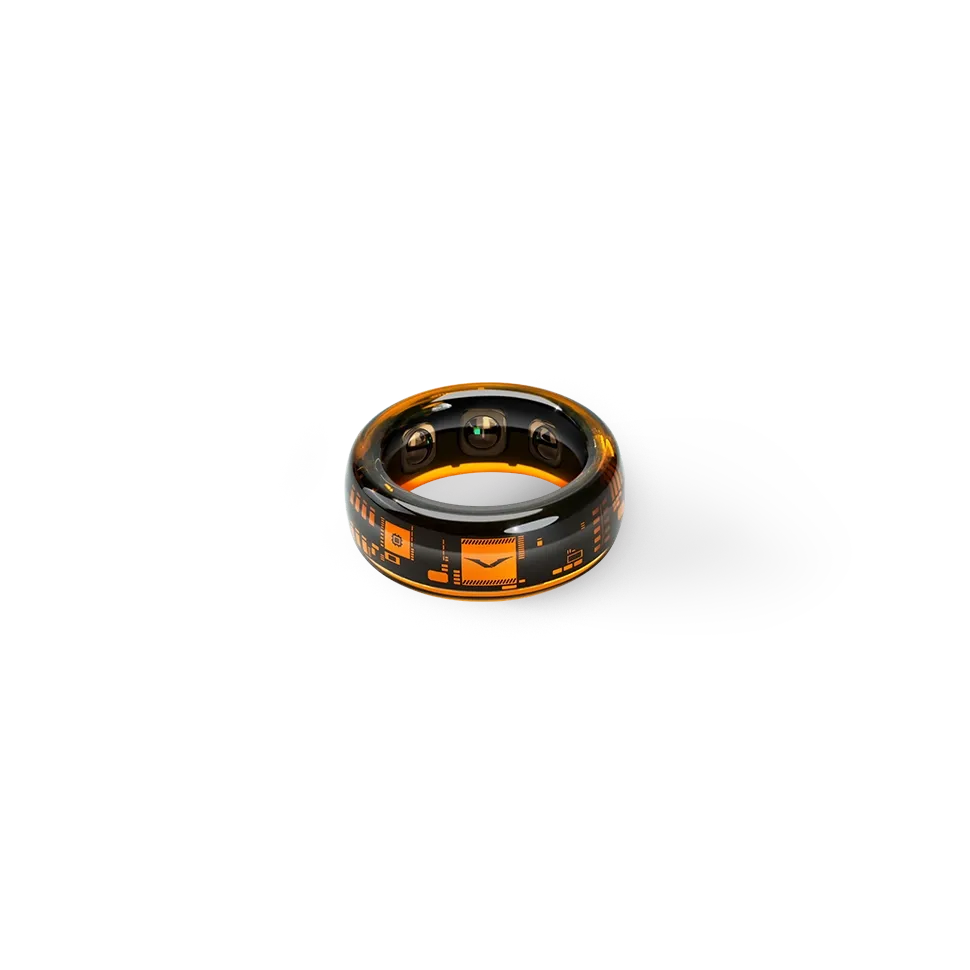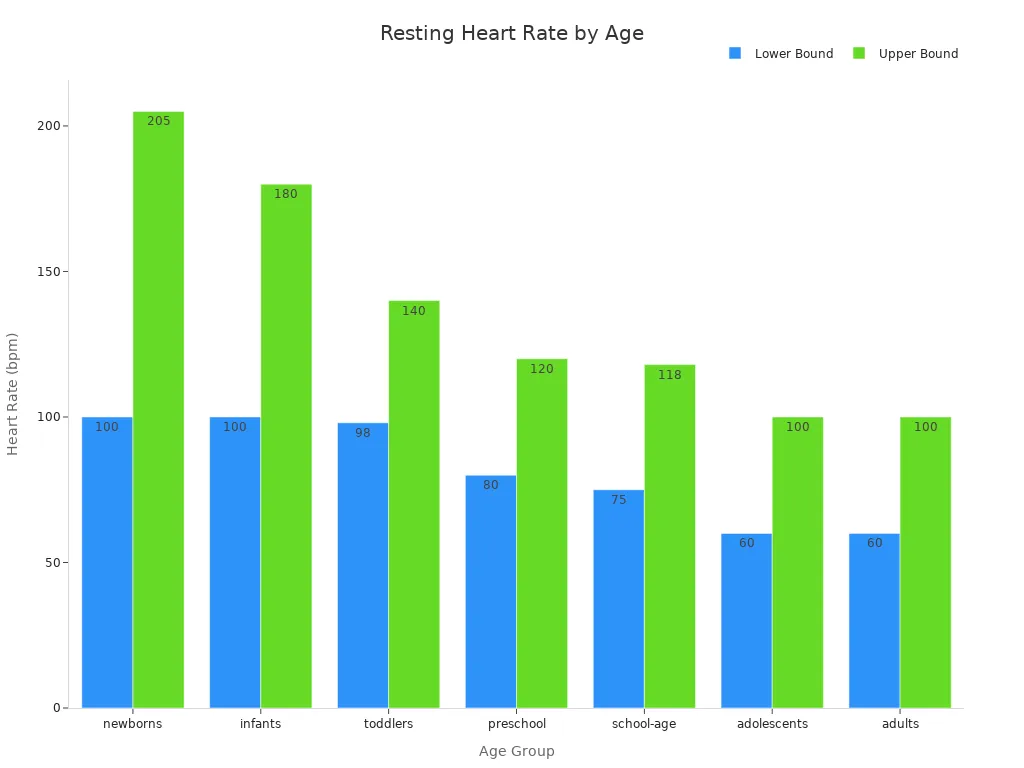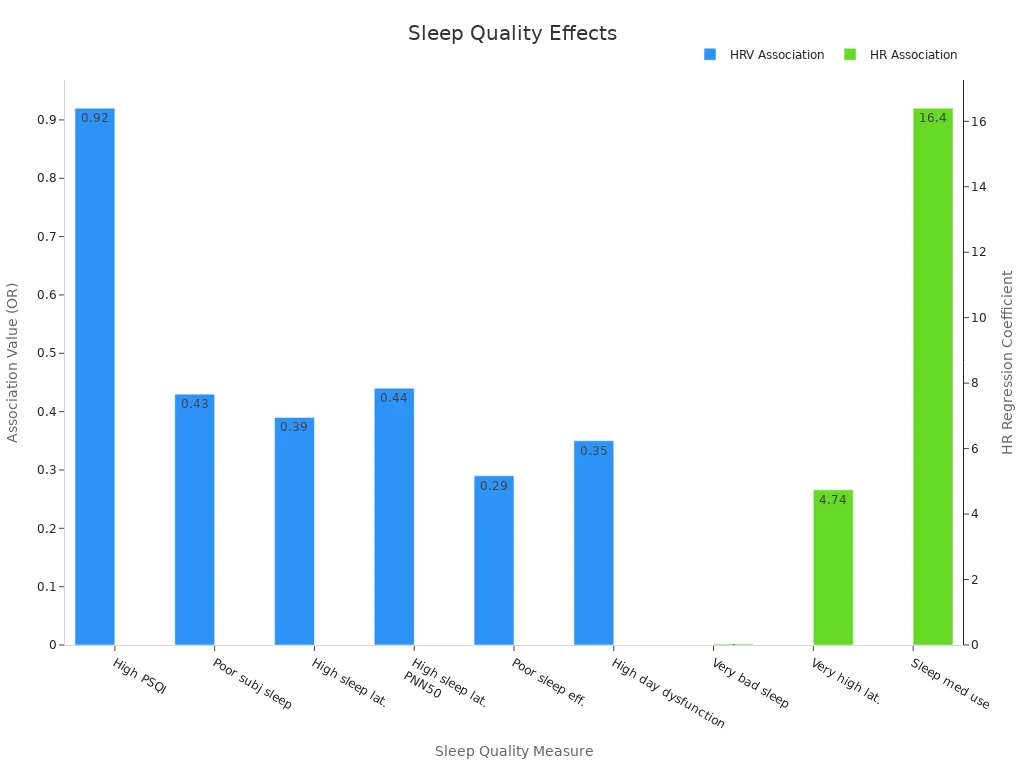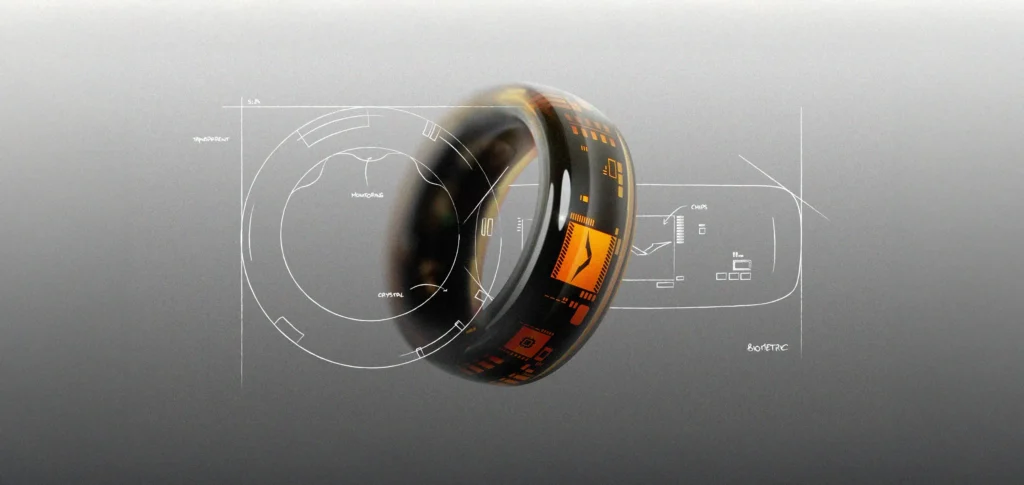
You want to know how to lower resting heart rate in a natural way. The oura ring gives you real-time feedback on your body. You see your resting heart rate each day. The oura ring tracks your sleep, activity, and stress. This smart ring shows you patterns that affect your resting heart rate. You can change your habits with help from the oura ring. You get daily tips and weekly reports from the oura ring. With the oura ring, you feel in control of your health.
Tip: Use the oura ring every day to spot changes in your resting heart rate and take action early.
Key Takeaways
-
The Aura Ring checks your resting heart rate, sleep, activity, and stress. It gives you easy-to-understand facts about your heart health each day.
-
Sleeping well can make your resting heart rate go down. Use the ring’s sleep data and tips to make your bedtime better and help your heart rest.
-
The Aura Ring shows your heart rate and HRV to help you handle stress. This helps you relax your body and keep your heart healthy.
-
Moving every day and staying active is good for your heart. The ring keeps track of this and can help lower your resting heart rate over time.
-
Use the Aura Ring’s data to set small and easy heart health goals. Watch how you do, and celebrate when you get better to keep healthy habits.
Why Resting Heart Rate Matters for Your Health

What Is Resting Heart Rate?
You might wonder what resting heart rate really means. It’s simple. Resting heart rate is the number of times your heart beats in one minute when you are calm and not moving. Doctors use this number to check how well your heart works. Most adults have a resting heart rate between 60 and 100 beats per minute (bpm). Kids and teens have higher rates, and babies have the highest.
Here’s a quick look at normal ranges for different age groups:
|
Age Group |
Normal Resting Heart Rate (bpm) |
|---|---|
|
Newborns |
100 – 205 |
|
Infants |
100 – 180 |
|
Toddlers |
98 – 140 |
|
Preschool Children |
80 – 120 |
|
School-age Children |
75 – 118 |
|
Adolescents |
60 – 100 |
|
Adults |
60 – 100 |

Your resting heart rate changes with age, fitness, and even the time of day. The autonomic nervous system controls it. When you relax, your heart slows down. When you get excited or stressed, it speeds up.
Why a Lower Resting Heart Rate Is Important
A lower resting heart rate often means your heart is strong and works well. If your heart beats fewer times each minute, it does not have to work as hard to pump blood. This can help your heart last longer and keep you feeling healthy.
Studies show that every 10 bpm increase in resting heart rate can raise your risk of health problems by 10%. People with a lower resting heart rate usually have a lower risk of heart disease and live longer. Doctors know that lowering your resting heart rate can help after a heart attack or if you have heart failure. Even though there is no perfect number for everyone, keeping your resting heart rate below 90 or 100 bpm is a good goal.
Tip: You can help your heart by tracking your resting heart rate and making small changes to your daily habits.
How the Oura Ring Tracks and Supports Heart Health
Continuous Heart Rate Monitoring with Oura Ring
You want to know what is happening inside your body. The oura ring gives you that power. It tracks your heart rate all day and night. You see your heart rate change when you rest, move, or sleep. This smart ring uses advanced nano-sensors to measure your heartbeats with high accuracy. You do not need to press any buttons or remember to check. The oura ring works quietly in the background, so you get a clear picture of your heart’s rhythm.
With the oura ring, you can spot trends in your heart rate. You might notice your heart rate drops after a good night’s sleep or rises when you feel stressed. The ring helps you understand how your daily choices affect your heart. You can use this information to make small changes that support a lower resting heart rate.
Tip: Wear your oura ring every day to see how your heart responds to different activities and routines.
Sleep Tracking and Its Effect on Resting Heart Rate
Sleep tracking with the oura ring shows you how your sleep affects your heart. The ring measures your sleep stages—light, deep, and REM—by combining motion and heart data. Studies show that changes in heart rate and hrv match up with these sleep stages. When you move from light sleep to deep sleep, your heart rate slows down and your hrv goes up. This means your body is recovering well.
Poor sleep can lead to a higher resting heart rate and a decrease in hrv. The oura ring helps you see when your sleep quality drops. You can use this insight to improve your bedtime habits and support your heart health.
Here’s a look at how sleep quality links to heart rate and hrv:
|
Sleep Quality Measure |
Cardiovascular Parameter |
Statistical Measure |
Value |
Interpretation |
|---|---|---|---|---|
|
Higher PSQI score (poor sleep quality) |
SDANN (HRV parameter) |
OR |
0.92 |
Poorer sleep quality associated with lower SDANN |
|
Poor subjective sleep quality |
SDANN |
OR |
0.43 |
Lower SDANN linked to poor subjective sleep quality |
|
High sleep latency |
SDANN |
OR |
0.39 |
High latency associated with lower SDANN |
|
High sleep latency |
PNN50 |
OR |
0.44 |
High latency associated with lower PNN50 |
|
Poor sleep efficiency |
SDANN |
OR |
0.29 |
Poor efficiency correlated with lower SDANN |
|
High daytime dysfunction |
SDANN |
OR |
0.35 |
Daytime dysfunction correlated with lower SDANN |
|
Very bad subjective sleep quality |
Heart Rate (HR) |
Regression Coefficient (B) |
0.03 |
Worse sleep quality linked to higher HR |
|
Very high sleep latency |
Heart Rate (HR) |
Regression Coefficient (B) |
4.74 |
High latency associated with increased HR |
|
Use of sleep medication (< once/week) |
Heart Rate (HR) |
Regression Coefficient (B) |
16.4 |
Sleep medication use linked to higher HR |

You can see that better sleep leads to a lower heart rate and an increase in hrv. The oura ring makes it easy to track these changes over time.
Heart Rate Variability (HRV) and Recovery Insights
The oura ring gives you daily hrv scores. HRV stands for heart rate variability. This number shows how much time passes between each heartbeat. A higher hrv means your body is handling stress well and recovering. A lower hrv or a decrease in hrv can mean your body feels tired or stressed.
Doctors use hrv to check how your heart and nervous system work together. Research shows that a decrease in hrv links to a higher risk of heart problems. The oura ring helps you spot a drop in hrv early. You can then take steps to rest, relax, or change your routine. If you see an increase in hrv, you know your body is bouncing back and getting stronger.
Note: HRV is a powerful tool for understanding your recovery. The oura ring makes it simple to track and improve your hrv every day.
Activity, Stress, and Recovery Data
You might wonder how your daily activity and stress levels affect your heart. The oura ring makes it easy to see the connection. Every step you take, every moment you rest, and even your stressful days show up in your data. The oura ring tracks your movement, exercise, and periods of stillness. You get a clear picture of how active you are each day.
When you feel stressed, your heart rate can go up. The oura ring picks up on these changes. It shows you how stress impacts your heart rate and hrv. You can spot patterns, like a higher heart rate after a busy day or a drop in hrv when you feel overwhelmed. This helps you understand what triggers stress for you.
Recovery matters just as much as activity. The oura ring gives you recovery scores based on your hrv and sleep quality. If your hrv drops, the ring might suggest you take it easy or get more rest. You can use these insights to plan your workouts and rest days. This way, you avoid pushing yourself too hard.
Here’s how you can use the oura ring’s data to support your heart health:
-
Check your daily activity score to see if you move enough.
-
Watch your hrv trends to know when your body needs rest.
-
Notice how stress affects your heart rate and recovery.
-
Use the ring’s tips to balance activity and relaxation.
Tip: Listen to your body. If your hrv is low or your heart rate is high, try deep breathing or a short walk to help your body recover.
The oura ring turns invisible signals from your body into easy-to-understand feedback. You get the power to make small changes that lead to a healthier heart.
How to Lower Resting Heart Rate Using Oura Ring Insights
Improving Sleep Quality with Oura Ring Data
Good sleep is one of the best answers to how to lower resting heart rate. The Aura Ring helps you see how well you sleep each night. You get a clear look at your sleep stages, bedtime, and wake-up time. The ring shows you if you spend enough time in deep sleep, which helps your heart slow down and recover.
You can use the ring’s sleep reports to spot patterns. Maybe you notice your resting heart rate drops after nights when you go to bed earlier. Or you see it rise when you stay up late or wake up often. The Aura Ring gives you tips to help you sleep better, like keeping a regular bedtime or making your room darker.
Try these steps to improve your sleep with Aura Ring data:
-
Check your sleep score each morning.
-
Look for nights when your resting heart rate is lower.
-
Follow the ring’s suggestions for better sleep routines.
-
Avoid screens and caffeine before bed.
Tip: Even small changes, like going to bed 30 minutes earlier, can help your heart and boost your overall wellbeing.
Managing Stress and Enhancing Recovery
Stress can make your heart beat faster. If you want to know how to lower resting heart rate, you need to manage stress. The Aura Ring tracks your heart rate and heart rate variability (HRV) all day. When you feel stressed, your HRV drops and your heart rate goes up. The ring shows you these changes right away.
You can use this feedback to calm your body. Try deep breathing, gentle stretching, or a short walk when you see your heart rate rise. The ring also gives you recovery scores. If your recovery score is low, take it easy that day. Rest helps your heart slow down and recover.
Here are some ways to use Aura Ring insights for stress and recovery:
-
Watch your HRV trends in the app.
-
Take breaks when your recovery score drops.
-
Practice relaxation exercises when your heart rate spikes.
-
Use the ring’s reminders to pause and breathe.
Remember: Your heart needs rest as much as it needs activity. Listening to your body is a key part of how to lower resting heart rate.
Optimizing Daily Activity for Heart Health
Moving your body every day is another answer to how to lower resting heart rate. The Aura Ring tracks your steps, exercise, and even how much you sit. You can see how your activity changes from day to day, week to week, and even by season.
Let’s look at some real data:
|
Aspect |
Findings |
|---|---|
|
Physical Activity (Steps) |
People walk more in summer (about 264 more steps) than in fall. |
|
|
Sundays have the lowest step counts (about 275 fewer steps than Fridays). |
|
|
Men take more steps daily than women (women take about 108 fewer steps). |
|
Heart Rate (HR) |
Nighttime heart rate in France averages 62.8 bpm. |
|
|
Women have higher heart rates than men (65.6 bpm vs 61.1 bpm). |
|
|
Resting heart rate drops a little during lockdown (about 0.3 bpm lower). |
|
|
Heart rate is higher in winter than in summer. |
|
|
Heart rate peaks around Christmas and New Year. |
You can use this information to plan your activity. Try to walk more on weekends or in winter when you might move less. The Aura Ring helps you set daily step goals and reminds you to move if you sit too long. When you stay active, your heart gets stronger and your resting heart rate can drop.
Here’s how to use Aura Ring data to support your heart:
-
Check your daily step count and aim for steady movement.
-
Notice how your heart rate changes after active days.
-
Use the ring’s activity reminders to avoid long periods of sitting.
-
Adjust your goals based on the season or your weekly routine.
Pro tip: Consistent movement, even if it’s just a little more each day, is a simple way to improve your heart health and support your wellbeing.
If you want to know how to lower resting heart rate, focus on sleep, stress, and daily movement. The Aura Ring gives you the tools and insights to make these changes part of your life. Over time, you’ll see your heart rate drop and your overall wellbeing improve.
Setting and Achieving Heart Health Goals
You want a healthier heart. You want to see your resting heart rate drop. The Aura Ring makes it easy to set clear goals and track your progress every day. You do not have to guess what works. The ring gives you real numbers and helpful feedback.
How to Set Heart Health Goals with Aura Ring
Start with small, realistic goals. You can pick one or two things to focus on first. Here are some ideas:
-
Lower your resting heart rate by 3-5 beats per minute over the next month.
-
Increase your average nightly sleep by 30 minutes.
-
Boost your daily step count by 1,000 steps.
-
Improve your HRV score by practicing relaxation each day.
The Aura Ring app lets you see your current numbers. You can check your trends and spot what needs work. The ring even suggests goals based on your data.
Tip: Write down your goals in the app or in a notebook. Seeing your goals helps you stay on track.
Tracking Progress and Staying Motivated
You get daily and weekly reports from the Aura Ring. These reports show your heart rate, sleep, activity, and recovery. You can see if you are moving closer to your goals.
Try this simple table to track your progress:
|
Goal |
Starting Value |
Current Value |
Goal Value |
Progress |
|---|---|---|---|---|
|
Resting Heart Rate (bpm) |
72 |
69 |
68 |
Almost there |
|
Sleep (hours/night) |
6.5 |
7.0 |
7.5 |
Improving |
|
Steps (per day) |
5,000 |
6,200 |
7,000 |
On track |
|
HRV (ms) |
45 |
50 |
55 |
Getting better |
You can update this table each week. Celebrate your wins, even the small ones! If you do not hit your goal, do not worry. The Aura Ring helps you see what to change.
Using Aura Ring Features to Reach Your Goals
The Aura Ring does more than track numbers. It gives you reminders and tips. You might get a nudge to move if you sit too long. You might see a suggestion to wind down if your sleep score drops. The ring’s AI learns your patterns and gives you advice that fits your life.
Here’s how you can use Aura Ring features every day:
-
Check your dashboard each morning. See your heart rate, sleep, and activity.
-
Follow the daily tips. Try a new bedtime or a short walk.
-
Set reminders. Use the app to remind you to move, relax, or go to bed.
-
Review your weekly report. Look for trends and adjust your goals if needed.
Note: Progress is not always a straight line. Some days will be better than others. Keep going and trust the process.
Making Heart Health a Habit
You build heart health one day at a time. The Aura Ring helps you turn healthy choices into habits. When you see your numbers improve, you feel proud. You want to keep going.
Try these ideas to make your goals stick:
-
Share your progress with a friend or family member.
-
Reward yourself for reaching a milestone (like a new book or a fun outing).
-
Use emojis or stickers in your app notes to make tracking fun. 🎯💪
You have the tools you need. The Aura Ring gives you clear feedback, smart tips, and gentle reminders. You can set goals, track your progress, and celebrate your success. Your heart will thank you!
Real-Life Experiences: Oura Ring and Lower Resting Heart Rate
Success Stories from Oura Ring Users
You might wonder if the Aura Ring really works for people like you. Many users share their stories about how the ring helped them lower their resting heart rate and feel healthier. Here are a few examples:
-
Sarah’s Journey: Sarah used to wake up tired and stressed. She started wearing the Aura Ring every night. The ring showed her that her sleep was too short and her heart rate stayed high. She followed the ring’s tips to go to bed earlier. After a few weeks, her resting heart rate dropped by 6 bpm. She felt more energy each morning.
-
Mike’s Progress: Mike wanted to get fit but didn’t know where to start. The Aura Ring tracked his steps and heart rate. He noticed his heart rate went up on stressful days. He used the ring’s reminders to take breaks and walk outside. Over time, his resting heart rate dropped, and he felt calmer.
-
Lily’s Success: Lily loved seeing her weekly reports. She set a goal to improve her sleep and walk more. The ring helped her track her progress. She celebrated each small win. Her resting heart rate improved, and she felt proud of her healthy habits.
“The Aura Ring made my health journey simple. I could see my progress every day.” – Sarah
Practical Tips for Lasting Results
You can get the most out of your Aura Ring by using a few simple tricks. Try these ideas to keep your heart healthy:
-
Wear your ring every day. Consistency helps you spot trends.
-
Check your data each morning. Look for changes in your heart rate and sleep.
-
Set small, clear goals. Focus on one habit at a time.
-
Follow the ring’s tips. Try new bedtime routines or short walks.
-
Celebrate your wins. Use emojis or notes in the app to stay motivated.
Tip: Share your progress with a friend. You can cheer each other on and stay on track!
With the Aura Ring, you have the tools and support you need. You can make small changes that add up to big results for your heart health.
You hold the power to improve your heart health with the Aura Ring. This smart ring gives you real-time insights for better sleep, less stress, and more movement. Studies show the Aura Ring tracks sleep with over 91% accuracy and strong reliability.
|
Performance Indicator |
Oura Ring Gen3 Results |
|---|---|
|
Sleep Tracking Accuracy |
91.7%–91.8% |
|
Overall Reliability |
94.8% |
Start using your Aura Ring today. Small changes add up. Your heart will thank you!
FAQ
How does the Aura Ring measure my resting heart rate?
The Aura Ring uses advanced nano-sensors to track your heartbeats. You just wear it on your finger. It checks your heart rate all day and night, so you always see your real resting heart rate.
Can the Aura Ring help me spot health problems early?
Yes! The Aura Ring watches for changes in your heart rate, sleep, and recovery. If something looks off, you get a gentle alert. You can take action before small issues become big problems.
Do I need to wear the Aura Ring all the time?
You get the best results when you wear the Aura Ring day and night. It feels light and comfortable, so you might forget you have it on. The more you wear it, the more helpful your data becomes.
Will the Aura Ring work with my phone?
The Aura Ring works with most phones. It connects to Android 8.0 or iOS 12.0 and above. You just download the app, pair your ring, and start tracking your health.
What makes the Aura Ring different from other smart rings?
The Aura Ring blends beautiful crystal design with powerful AI health tracking. It gives you real-time insights, weekly wellness reports, and expert support. You get a ring that looks stunning and helps you feel your best.




